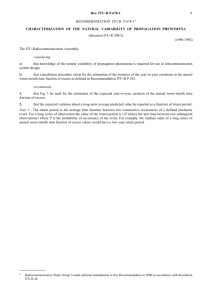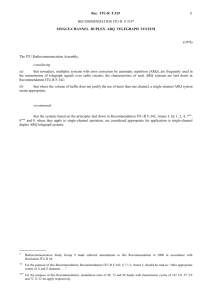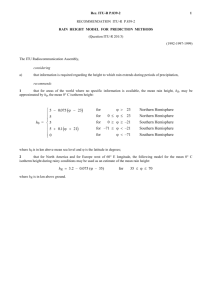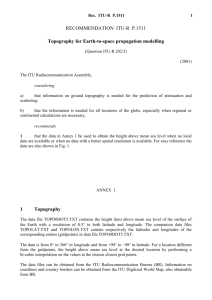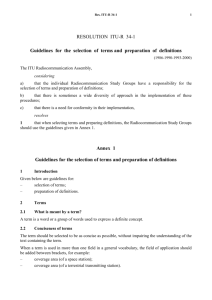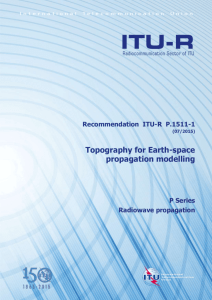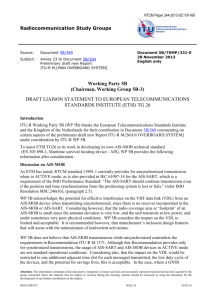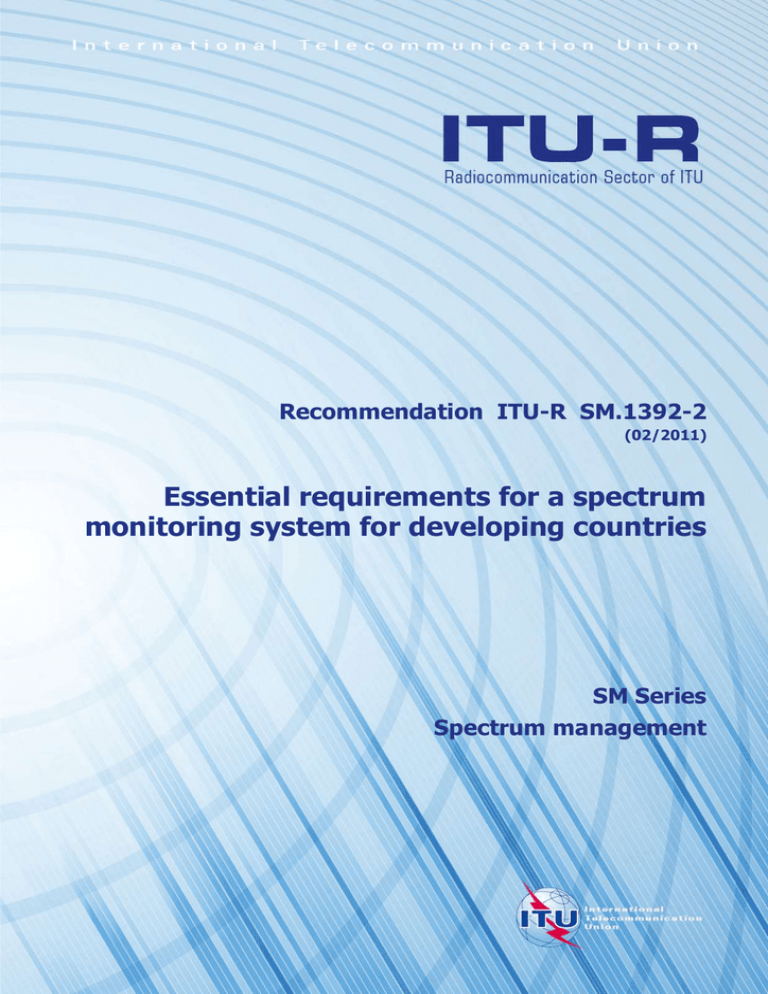
Recommendation ITU-R SM.1392-2
(02/2011)
Essential requirements for a spectrum
monitoring system for developing countries
SM Series
Spectrum management
ii
Rec. ITU-R SM.1392-2
Foreword
The role of the Radiocommunication Sector is to ensure the rational, equitable, efficient and economical use of the
radio-frequency spectrum by all radiocommunication services, including satellite services, and carry out studies without
limit of frequency range on the basis of which Recommendations are adopted.
The regulatory and policy functions of the Radiocommunication Sector are performed by World and Regional
Radiocommunication Conferences and Radiocommunication Assemblies supported by Study Groups.
Policy on Intellectual Property Right (IPR)
ITU-R policy on IPR is described in the Common Patent Policy for ITU-T/ITU-R/ISO/IEC referenced in Annex 1 of
Resolution ITU-R 1. Forms to be used for the submission of patent statements and licensing declarations by patent
holders are available from http://www.itu.int/ITU-R/go/patents/en where the Guidelines for Implementation of the
Common Patent Policy for ITU-T/ITU-R/ISO/IEC and the ITU-R patent information database can also be found.
Series of ITU-R Recommendations
(Also available online at http://www.itu.int/publ/R-REC/en)
Series
BO
BR
BS
BT
F
M
P
RA
RS
S
SA
SF
SM
SNG
TF
V
Title
Satellite delivery
Recording for production, archival and play-out; film for television
Broadcasting service (sound)
Broadcasting service (television)
Fixed service
Mobile, radiodetermination, amateur and related satellite services
Radiowave propagation
Radio astronomy
Remote sensing systems
Fixed-satellite service
Space applications and meteorology
Frequency sharing and coordination between fixed-satellite and fixed service systems
Spectrum management
Satellite news gathering
Time signals and frequency standards emissions
Vocabulary and related subjects
Note: This ITU-R Recommendation was approved in English under the procedure detailed in Resolution ITU-R 1.
Electronic Publication
Geneva, 2011
ITU 2011
All rights reserved. No part of this publication may be reproduced, by any means whatsoever, without written permission of ITU.
Rec. ITU-R SM.1392-2
1
RECOMMENDATION ITU-R SM.1392-2
Essential requirements for a spectrum monitoring system
for developing countries
(1999-2000-2011)
Scope
The specific situation in developing countries, particularly budget limitations, requires careful
planning of a national spectrum monitoring system. This Recommendation provides some guidance
in this regard.
The ITU Radiocommunication Assembly,
considering
a)
that the increasing use of radio services in the developing countries requires more efficient
use of the radio-frequency spectrum;
b)
that spectrum monitoring is an important tool for frequency management in general, and for
verification of efficient use of the radio-frequency spectrum in particular;
c)
that spectrum monitoring systems are often the most expensive part of a national spectrum
management system whose optimal implementation, including networking, has a significant
economic impact;
d)
that spectrum monitoring equipment becomes more and more sophisticated, providing more
and more new functions, and its appropriate operation requires the availability of highlyprofessional and well-trained personnel, as well as the availability of the necessary infrastructure for
testing, calibration and maintenance of the equipment, including antennas;
e)
that Recommendation ITU-R SM.1050 defines the tasks of a monitoring service;
f)
that it is necessary to specify minimum requirements for monitoring systems of developing
countries, so that these systems may fulfil their tasks for national spectrum management, and can be
part of the international monitoring system,
noting
the revision of the ITU Handbook on Spectrum Monitoring approved in 2010,
recommends
that monitoring systems in developing countries should be designed to meet the requirements of
Annex 1, in order to perform the tasks set out in Recommendation ITU-R SM.1050, but tailored to
the national requirements.
2
Rec. ITU-R SM.1392-2
Annex 1
1
Introduction
In principle, radio monitoring stations of developing countries and developed countries have the
same tasks, and hence the same requirements. The difference in terms of available budget and
available manpower, however, might be substantial. Therefore, thorough planning and careful
design are essential to minimise this difference.
The purpose of this Recommendation is to provide some guidance on how to establish a spectrum
monitoring system within scarce available resources.
2
Tasks
2.1
General tasks
There are four main tasks of a radio monitoring service, which can be derived from the
Radio Regulations (RR):
–
monitoring of emissions for compliance with the provisions of the frequency assignment;
–
frequency band observations and channel occupancy measurements;
–
investigation of cases of harmful interference;
–
identification and elimination of illegal emissions.
These are further specified in Recommendation ITU-R SM.1050.
Chapters 1 and 2 of the ITU Handbook on Spectrum Monitoring approved in 2010 (hereinafter “the
Handbook”) list further tasks, such as the on-site inspection of radio stations, which may be
assigned to a radio monitoring service.
2.2
Measurement tasks
Closer examination of these general tasks leads to specific measurement tasks which can be found
in Recommendation ITU-R SM.1050 and Chapter 2 of the Handbook, e.g.:
–
frequency measurements;
–
field strength and power-flux density measurements;
–
bandwidth measurements;
–
modulation measurements;
–
spectrum occupancy measurements;
–
signal analysis and transmitter identification;
–
direction finding and location determination.
Chapter 4 of the Handbook provides detailed information on the measurements of these basic
parameters. Chapter 5 of the Handbook describes more specific monitoring systems and procedures.
3
Scope of the radio monitoring system
Having limited budgets and certain requirements in mind, the scope of the radio monitoring system
has to be restricted. For this purpose first some questions like the following ones have to be
answered:
–
What in detail is expected from the radio monitoring service?
Rec. ITU-R SM.1392-2
–
–
–
–
–
–
–
–
–
3
Which fields of activities are of great public, political or commercial interest?
What is the frequency range of interest?
Which radio services are essential to be monitored?
Which regions of the country are essential to be provided by monitoring at the current stage
of the country economics development and at what extent they should be covered by
monitoring?
What are the consequences of not covering a frequency range, a radio service or a task or a
region of the territory?
Can sufficient amount of highly professional and well trained operational staff be made
available?
Can the necessary infrastructure for testing, calibration and maintenance of the equipment
including antennas be made available?
Is there a need for data exchange between monitoring stations and monitoring centers and,
if so, is the necessary infrastructure available?
Is there any other institution available that could accomplish some of these tasks?
As these questions are interconnected and cannot be answered independently, they have to be
considered in relation to operational issues. Resulting questions could be for example:
–
Is there a need to monitor public mobile telephone networks and to measure their radio
coverage or can this task be assigned to the network operator?
–
Does the number of licenses issued for fixed links justify the procurement of special
equipment for measurements up to 40 GHz or even higher?
–
Which radiocommunication services are most affected by interference or by illegal
operation and in which regions of the territory are they located?
4
Planning of a Radio Monitoring System
Upon answering the above mentioned questions, the required monitoring systems as well as the
necessary infrastructure can be determined on the basis of finance resources available. In this
regard, special attention shall be given to the required number of monitoring stations, and the siting
and remote control of monitoring stations.
Section 6.8 of the Handbook provides guidance on planning and optimisation of spectrum
monitoring networks in the context of monitoring coverage.
Requirements on the siting and environmental protection of monitoring stations are presented in
§ 2.6 of the Handbook. It has to be understood that siting of monitoring station is a very important
step as free and appropriate sites might not be found easily.
Section 2.5 of the Handbook provides details about the remote control of monitoring stations. The
means of connection between different monitoring station sites, and also between these sites and the
main control centre, has to be carefully considered.
Annex 1 of the Handbook gives guidance on monitoring system planning in relation to equipment
and relevant tender process.
4
5
Rec. ITU-R SM.1392-2
Equipment
Basically, all radio monitoring stations are composed of antennas, receivers or analyzers, direction
finders and signal analysis and/or recording equipment. Modern equipment offers a high level of
automation, and may accommodate several functions in one unit. For example, a receiver could
include a DF function. Sometimes it is possible to upgrade such functions later.
Nevertheless, an external PC or laptop computer is required for automated or remote control of the
equipment and for the documentation of the results.
5.1
Antennas
Suitable antennas are indispensible for all frequency ranges to be monitored. Antennas can be
categorised in various ways, e.g.:
–
passive/active antennas;
–
low/high gain antennas;
–
suitable for fixed/mobile/transportable use;
–
directional/omnidirectional/direction-finding antennas.
The various antenna types have different inherent advantages and disadvantages, depending on the
individual application. For field strength measurements, the antenna’s frequency-dependent antenna
factor (k-factor) must be known.
Ample information on antennas can be found in Chapter 3 of the Handbook. Section 2.6 of the
Handbook discusses site criteria and antenna protection measures.
5.2
Receivers and analyzers
Receivers and spectrum analyzers are indispensible tools of all radio monitoring services. The basic
difference is that receivers normally provide pre-selection in the RF front-end and are designed for
demodulation purposes, whereas spectrum analyzers are designed to display the spectral
characteristics of the RF spectrum.
Measurements of analogue radio services, including measurements of frequency deviation and
multiplex power of an FM broadcasting signal, for example, have to be performed with a receiver.
Field strength measurements are also carried out using receivers. The measurement of parameters
such as frequency and bandwidth can also be performed using a spectrum analyzer. They may also
be used for measurements of digitally modulated signals, or for the detection of unknown sources of
interference.
Modern receivers may include some features which normally are expected from a spectrum
analyzer. Conversely, a spectrum analyzer operated in zero-span mode may provide some receiver
functions.
Meanwhile, FFT analysis in both receivers and spectrum analyzers has become affordable and
should be preferred. This is not necessarily more costly than conventional sweeping analysis.
Regarding receiver specifications, Chapter 3 of the Handbook and Recommendations
ITU-R SM.1836, ITU-R SM.1837, ITU-R SM.1838, ITU-R SM.1839 and ITU-R SM.1840, and
Report ITU-R SM.2125 may be consulted.
Recommendations ITU-R SM.377 and ITU-R SM.443 as well as §§ 4.2 and 4.5 of the Handbook
describe the measurement of frequency and bandwidth in detail.
Rec. ITU-R SM.1392-2
5
Details on field strength and power flux-density measurements can be found in Recommendation
ITU-R SM.378 and in § 4.4 of the Handbook. Field-strength measurements along a route with
geographical coordinate registrations, important for radiocommunication coverage area
determination, are presented in Recommendation ITU-R SM.1875, and other considerations
concerning coverage measurements are given in § 4.11 of the Handbook. Recommendation ITU-R
SM.1708 details coverage measurements that apply to digital TV broadcasting.
5.3
Direction finding and location determination
Direction finders (DF) are probably the most effective tools for the location of sources of harmful
interference and for finding unauthorised transmitters. At the same time, they are often one of the
most costly tools of a radio monitoring service.
Preserving budget requires careful planning of fixed DF sites in order to minimize their number
while providing required location coverage and accuracy. Section 6.8 of the Handbook provides
useful guidance on this topic. The temporary deployment of transportable DF stations may also be
considered to extend coverage.
Planning fixed, mobile and transportable DF equipment requires prior consideration of the intended
purpose. This has substantial influence on the specifications, e.g. the required frequency range and
minimum signal duration. It should also be noted that mobile DFs are particularly useful for
homing, whereas the determination of transmitter locations is the domain of fixed or transportable
DF stations. For locating an interfering or illegal transmitter, a mobile monitoring station is
necessary. One could also consider whether homing receivers might be helpful for some
applications. Increased location reliability at frequencies above 30 MHz usually requires several DF
stations for the triangulation process. For frequencies below 30 MHz, at least one single site
location (SSL) station may be provided.
Example of DF limitation considerations: The occurrence of fixed links at 26 GHz and the
appearance of high speed data applications, as such, would not justify the procurement of direction
finders for that frequency band, or to specify very low minimum signal duration.
Section 4.7 of the Handbook should carefully be studied before any decisions are made.
5.4
Equipment for occupancy measurements and recording equipment
Channel occupancy, and band utilisation in general, are useful information for spectrum
management. Specialized spectrum recorders facilitate simultaneous measurements of several
bands, but require huge storage capacity. Sometimes the equipment requirements can be reduced,
e.g. by reducing the recording time, by limiting the span to be observed or by increasing the
necessary re-visit time of a frequency during measurement. Under these circumstances, the use of a
modern FFT receiver facilitating spectrograms and occupancy measurements without additional
equipment should be considered. In many cases, standard monitoring receivers or spectrum
analyzers can also be used in conjunction with a computer running software that controls the
equipment and stores the data. Section 4.10 of the Handbook forms the basis for the relevant
measurements.
5.5
Equipment for modulation measurements
Standard monitoring receivers already provide some analogue and/or digital demodulation
capabilities and an IF output for further analysis. It very much depends on the analysis according to
§ 2 above whether specific modulation analyzers are required. Detailed information about
modulation measurements can be found in § 4.6 of the Handbook.
6
5.6
Rec. ITU-R SM.1392-2
Identification and decoding equipment
The identification of a radio signal one of the most difficult tasks of a radio monitoring service.
Recommendation ITU-R SM.1052 lists some requirements regarding the automatic identification of
radio stations in the HF band. A more thorough discussion on signal analysis and transmitter
identification can be found in § 4.8 of the Handbook.
6
Fixed vs. mobile and transportable monitoring stations
Mobile monitoring stations are indispensible for monitoring tasks in the field, in particular for the
identification of sources of harmful interference and unauthorised transmitters. The number of
vehicles may be limited by various factors. Budget is usually the most important one. This in turn
requires the design and procurement of multipurpose monitoring vehicles instead of special vehicles
where possible. However, limits of vehicle size and payload require compromises.
Monitoring using antenna heights above 10 m is difficult to accomplish in mobile stations, so fixed
or transportable stations are usually used in that case. A radio monitoring service needs a building
with offices, a storage room and a repair shop. Sometimes a few antennas can be installed on the
roof. In the majority of cases, however, the use of separate antenna towers will be more appropriate.
Chapter 2 of the Handbook discusses various types of monitoring stations, including mobile
stations.
7
Software, interfaces
Besides standard office software comprising text processing and spreadsheet programs, a radio
monitoring service needs additional software dedicated to the measurement equipment. This
software automates routine and repetitive measurement processes, can inform or alert the operator
when specific criteria are met, and provides other features to aid the operator in understanding the
kinds of signals and interference being monitored (examples are given in § 3.6.2 of the Handbook).
Furthermore, it is very important that the radio monitoring service has access to the complete
license database to allow comparison with monitoring results and to identify possible license
violations and unlicensed transmitters.
Such an access allows automation and integration of spectrum monitoring systems with automated
spectrum management (Recommendation ITU-R SM.1537).
8
Organisation
Limited budgets normally go along with a lack of staff. This requires wide-ranging staff training
and a flat hierarchy. In some administrations, the spectrum monitoring staff has to fulfil spectrum
management and inspection tasks too. Several sections in Chapter 2 and Annex 1 of the Handbook
deal with the structure and organisation of a radio monitoring service and with staff training,
because these are essential elements affecting the efficiency of the whole system. The same
concerns the necessary infrastructure for repairing, tuning, calibrating, testing and maintaining the
equipment, including antennas.

